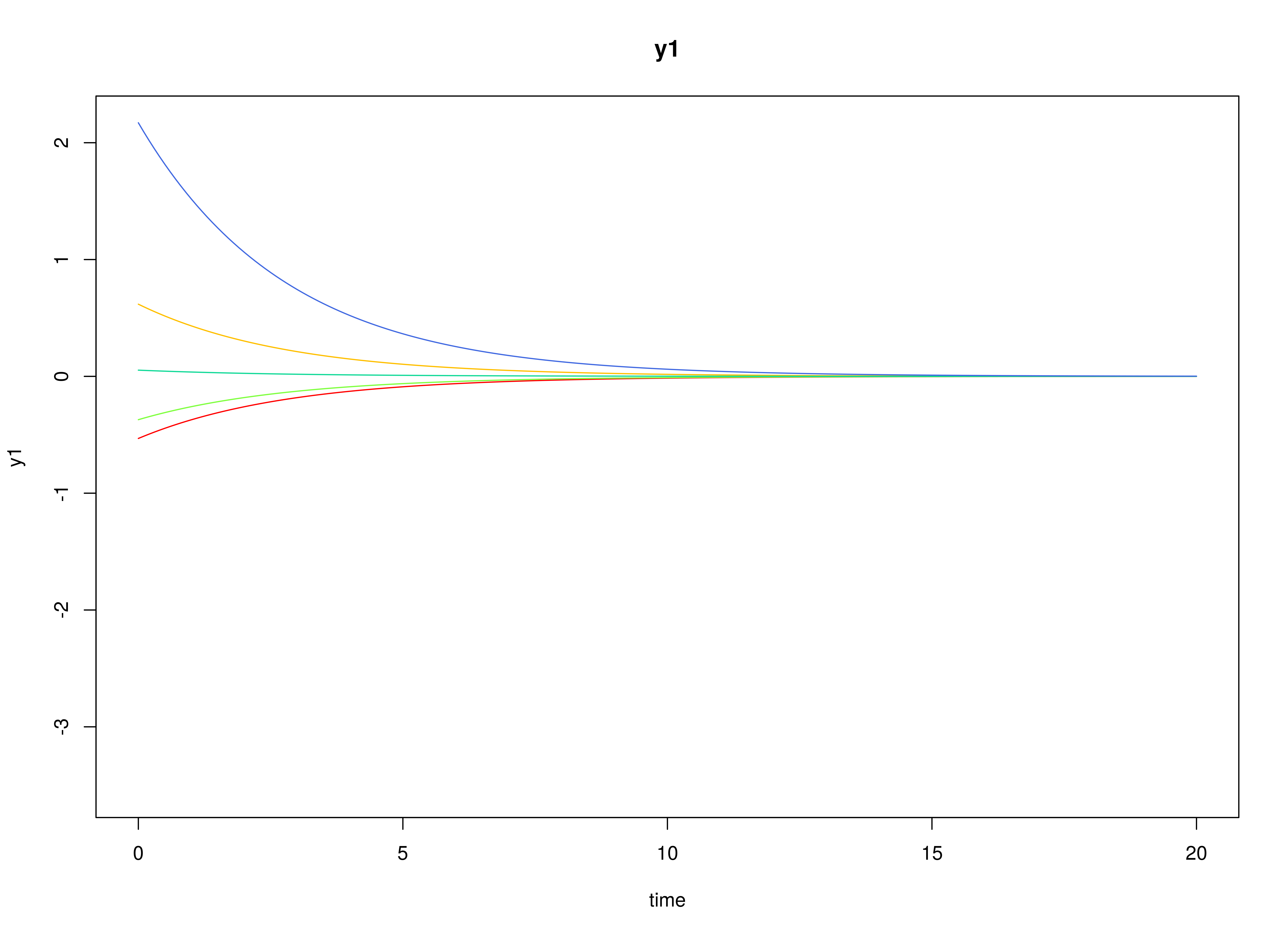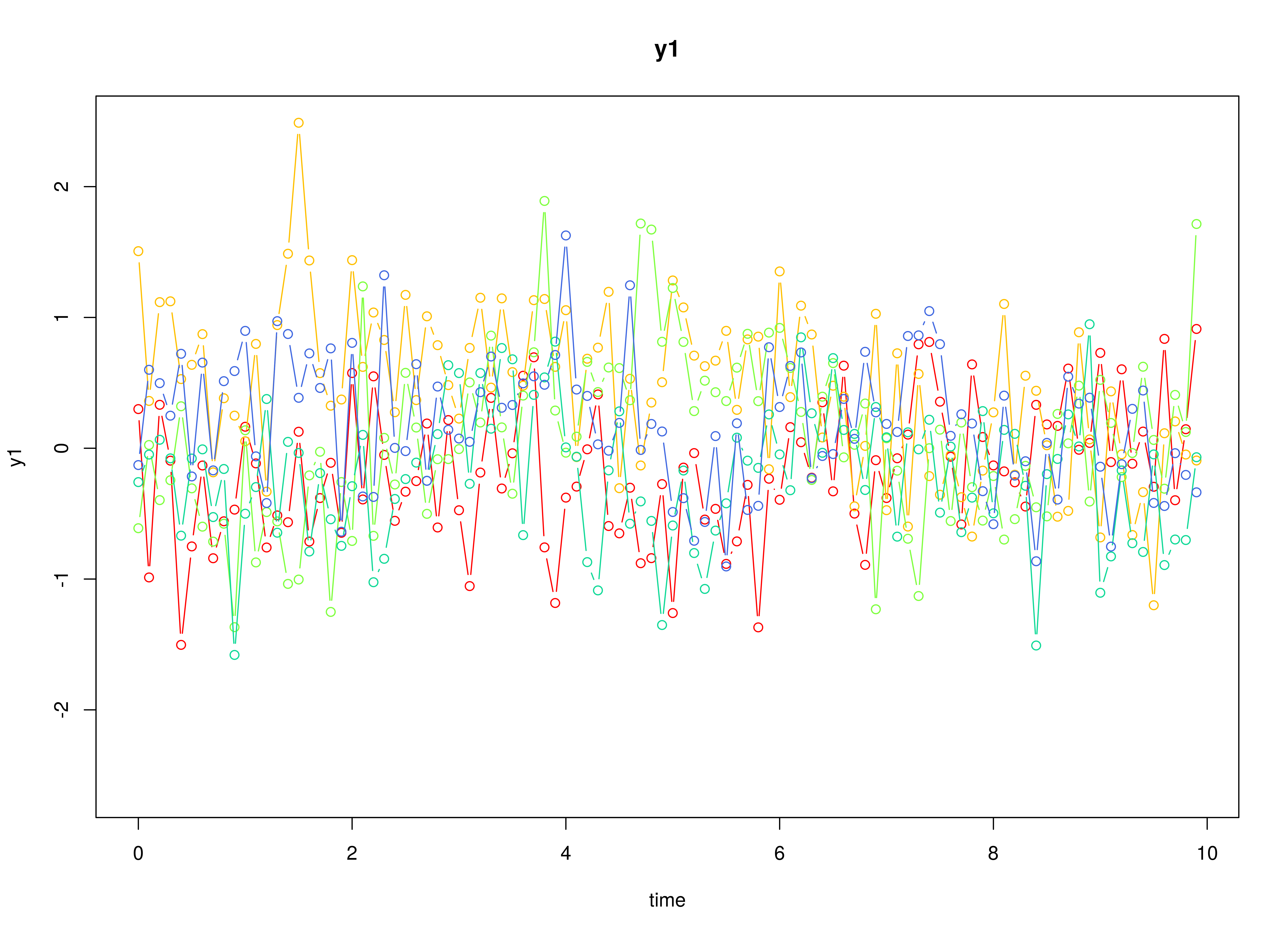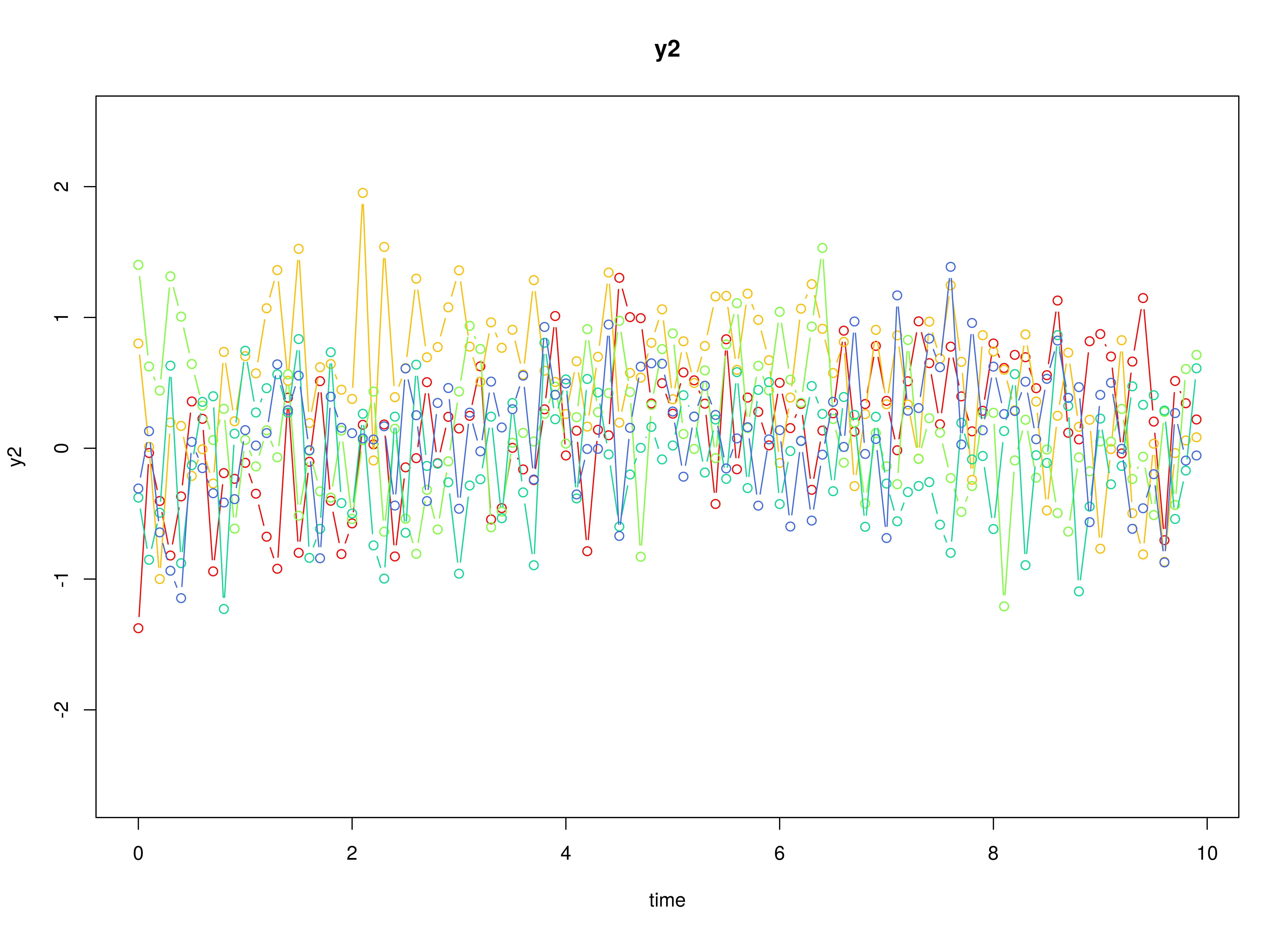Model
The measurement model is given by where , , and are random variables and , , and are model parameters. represents a vector of observed random variables, a vector of latent random variables, and a vector of random measurement errors, at time and individual . denotes a vector of intercepts, a matrix of factor loadings, and the covariance matrix of .
An alternative representation of the measurement error is given by where is a vector of independent standard normal random variables and .
The dynamic structure is given by where is the long-term mean or equilibrium level, is the rate of mean reversion, determining how quickly the variable returns to its mean, is the matrix of volatility or randomness in the process, and is a Wiener process or Brownian motion, which represents random fluctuations.
Data Generation
Notation
Let be the number of time points and be the number of individuals.
Let the measurement model intecept vector be given by
Let the factor loadings matrix be given by
Let the measurement error covariance matrix be given by
Let the initial condition be given by
Let the long-term mean vector be given by
Let the rate of mean reversion matrix be given by
Let the dynamic process noise covariance matrix be given by
Let .
R Function Arguments
n
#> [1] 100
time
#> [1] 500
delta_t
#> [1] 0.1
mu0
#> [1] 0 0 0
sigma0
#> [,1] [,2] [,3]
#> [1,] 0.3425148 0.3296023 0.0343817
#> [2,] 0.3296023 0.5664625 0.2545955
#> [3,] 0.0343817 0.2545955 0.2999909
sigma0_l # sigma0_l <- t(chol(sigma0))
#> [,1] [,2] [,3]
#> [1,] 0.58524763 0.0000000 0.0000000
#> [2,] 0.56318429 0.4992855 0.0000000
#> [3,] 0.05874726 0.4436540 0.3157701
mu
#> [1] 0 0 0
phi
#> [,1] [,2] [,3]
#> [1,] -0.357 0.000 0.000
#> [2,] 0.771 -0.511 0.000
#> [3,] -0.450 0.729 -0.693
sigma
#> [,1] [,2] [,3]
#> [1,] 0.24455556 0.02201587 -0.05004762
#> [2,] 0.02201587 0.07067800 0.01539456
#> [3,] -0.05004762 0.01539456 0.07553061
sigma_l # sigma_l <- t(chol(sigma))
#> [,1] [,2] [,3]
#> [1,] 0.49452559 0.0000000 0.000000
#> [2,] 0.04451917 0.2620993 0.000000
#> [3,] -0.10120330 0.0759256 0.243975
nu
#> [1] 0 0 0
lambda
#> [,1] [,2] [,3]
#> [1,] 1 0 0
#> [2,] 0 1 0
#> [3,] 0 0 1
theta
#> [,1] [,2] [,3]
#> [1,] 0.2 0.0 0.0
#> [2,] 0.0 0.2 0.0
#> [3,] 0.0 0.0 0.2
theta_l # theta_l <- t(chol(theta))
#> [,1] [,2] [,3]
#> [1,] 0.4472136 0.0000000 0.0000000
#> [2,] 0.0000000 0.4472136 0.0000000
#> [3,] 0.0000000 0.0000000 0.4472136Visualizing the Dynamics Without Measurement Error and Process Noise (n = 5 with Different Initial Condition)



Using the SimSSMOUFixed Function from the
simStateSpace Package to Simulate Data
library(simStateSpace)
sim <- SimSSMOUFixed(
n = n,
time = time,
delta_t = delta_t,
mu0 = mu0,
sigma0_l = sigma0_l,
mu = mu,
phi = phi,
sigma_l = sigma_l,
nu = nu,
lambda = lambda,
theta_l = theta_l,
type = 0
)
data <- as.data.frame(sim)
head(data)
#> id time y1 y2 y3
#> 1 1 0.0 0.45047365 -1.2185550 0.6708638
#> 2 1 0.1 -0.84190461 0.1242594 0.1813493
#> 3 1 0.2 0.47289651 -0.2398710 0.5995107
#> 4 1 0.3 0.04089817 -0.6547109 0.4674929
#> 5 1 0.4 -1.37222946 -0.2010512 -0.3341885
#> 6 1 0.5 -0.62410106 0.5262251 -0.1892906
summary(data)
#> id time y1 y2
#> Min. : 1.00 Min. : 0.00 Min. :-3.088974 Min. :-3.3705197
#> 1st Qu.: 25.75 1st Qu.:12.47 1st Qu.:-0.495395 1st Qu.:-0.5869853
#> Median : 50.50 Median :24.95 Median :-0.001893 Median :-0.0004440
#> Mean : 50.50 Mean :24.95 Mean : 0.001892 Mean : 0.0001166
#> 3rd Qu.: 75.25 3rd Qu.:37.42 3rd Qu.: 0.499799 3rd Qu.: 0.5876892
#> Max. :100.00 Max. :49.90 Max. : 3.381345 Max. : 3.4729591
#> y3
#> Min. :-2.909151
#> 1st Qu.:-0.479502
#> Median :-0.005854
#> Mean :-0.002427
#> 3rd Qu.: 0.471538
#> Max. : 2.847363
plot(sim)


Model Fitting
Prepare Initial Condition
dynr_initial <- dynr::prep.initial(
values.inistate = mu0,
params.inistate = c("mu0_1_1", "mu0_2_1", "mu0_3_1"),
values.inicov = sigma0,
params.inicov = matrix(
data = c(
"sigma0_1_1", "sigma0_2_1", "sigma0_3_1",
"sigma0_2_1", "sigma0_2_2", "sigma0_3_2",
"sigma0_3_1", "sigma0_3_2", "sigma0_3_3"
),
nrow = 3
)
)Prepare Measurement Model
dynr_measurement <- dynr::prep.measurement(
values.load = diag(3),
params.load = matrix(data = "fixed", nrow = 3, ncol = 3),
state.names = c("eta_1", "eta_2", "eta_3"),
obs.names = c("y1", "y2", "y3")
)Prepare Dynamic Process
dynr_dynamics <- dynr::prep.formulaDynamics(
formula = list(
eta_1 ~ (phi_1_1 * (eta_1 - mu_1_1)) + (phi_1_2 * (eta_2 - mu_2_1)) + (phi_1_3 * (eta_3 - mu_3_1)),
eta_2 ~ (phi_2_1 * (eta_1 - mu_1_1)) + (phi_2_2 * (eta_2 - mu_2_1)) + (phi_2_3 * (eta_3 - mu_3_1)),
eta_3 ~ (phi_3_1 * (eta_1 - mu_1_1)) + (phi_3_2 * (eta_2 - mu_2_1)) + (phi_3_3 * (eta_3 - mu_3_1))
),
startval = c(
mu_1_1 = mu[1], mu_2_1 = mu[2], mu_3_1 = mu[3],
phi_1_1 = phi[1, 1], phi_1_2 = phi[1, 2], phi_1_3 = phi[1, 3],
phi_2_1 = phi[2, 1], phi_2_2 = phi[2, 2], phi_2_3 = phi[2, 3],
phi_3_1 = phi[3, 1], phi_3_2 = phi[3, 2], phi_3_3 = phi[3, 3]
),
isContinuousTime = TRUE
)Prepare Process Noise
dynr_noise <- dynr::prep.noise(
values.latent = sigma,
params.latent = matrix(
data = c(
"sigma_1_1", "sigma_2_1", "sigma_3_1",
"sigma_2_1", "sigma_2_2", "sigma_3_2",
"sigma_3_1", "sigma_3_2", "sigma_3_3"
),
nrow = 3
),
values.observed = theta,
params.observed = matrix(
data = c(
"theta_1_1", "fixed", "fixed",
"fixed", "theta_2_2", "fixed",
"fixed", "fixed", "theta_3_3"
),
nrow = 3
)
)Prepare the Model
model <- dynr::dynr.model(
data = dynr_data,
initial = dynr_initial,
measurement = dynr_measurement,
dynamics = dynr_dynamics,
noise = dynr_noise,
outfile = "ou.c"
)Add lower and upper bounds to aid in the optimization.
model$lb[
c(
"phi_1_1",
"phi_1_2",
"phi_1_3",
"phi_2_1",
"phi_2_2",
"phi_2_3",
"phi_3_1",
"phi_3_2",
"phi_3_3"
)
] <- -1.5
model$ub[
c(
"phi_1_1",
"phi_1_2",
"phi_1_3",
"phi_2_1",
"phi_2_2",
"phi_2_3",
"phi_3_1",
"phi_3_2",
"phi_3_3"
)
] <- +1.5
Fit the Model
results <- dynr::dynr.cook(
model,
debug_flag = TRUE,
verbose = FALSE
)
#> [1] "Get ready!!!!"
#> using C compiler: ‘gcc (Ubuntu 13.3.0-6ubuntu2~24.04) 13.3.0’
#> Optimization function called.
#> Starting Hessian calculation ...
#> Finished Hessian calculation.
#> Original exit flag: 3
#> Modified exit flag: 3
#> Optimization terminated successfully: ftol_rel or ftol_abs was reached.
#> Original fitted parameters: 0.0003601474 0.0005084053 0.001608575 -0.3219241
#> -0.02788176 0.01542201 0.7628195 -0.5073321 0.01114979 -0.4479966 0.7295014
#> -0.6992285 -1.421929 0.0879919 -0.2133477 -2.668744 0.2834391 -2.863673
#> -1.607219 -1.615048 -1.605471 -0.03091122 -0.03188498 -0.01945298 -1.185041
#> 1.151406 0.2899886 -1.512262 0.9287701 -1.887663
#>
#> Transformed fitted parameters: 0.0003601474 0.0005084053 0.001608575
#> -0.3219241 -0.02788176 0.01542201 0.7628195 -0.5073321 0.01114979 -0.4479966
#> 0.7295014 -0.6992285 0.2412483 0.02122789 -0.05146976 0.07120711 0.01512453
#> 0.07361031 0.2004442 0.1988811 0.200795 -0.03091122 -0.03188498 -0.01945298
#> 0.3057336 0.3520235 0.08865926 0.6257328 0.3067938 0.367265
#>
#> Doing end processing
#> Successful trial
#> Total Time: 1.083398
#> Backend Time: 1.083212Summary
summary(results)
#> Coefficients:
#> Estimate Std. Error t value ci.lower ci.upper Pr(>|t|)
#> mu_1_1 0.0003601 0.0200307 0.018 -0.0388994 0.0396197 0.4928
#> mu_2_1 0.0005084 0.0324819 0.016 -0.0631550 0.0641718 0.4938
#> mu_3_1 0.0016086 0.0210399 0.076 -0.0396289 0.0428460 0.4695
#> phi_1_1 -0.3219241 0.0667150 -4.825 -0.4526831 -0.1911650 <2e-16 ***
#> phi_1_2 -0.0278818 0.0587554 -0.475 -0.1430403 0.0872768 0.3176
#> phi_1_3 0.0154220 0.0441210 0.350 -0.0710537 0.1018977 0.3633
#> phi_2_1 0.7628195 0.0355593 21.452 0.6931245 0.8325146 <2e-16 ***
#> phi_2_2 -0.5073321 0.0316662 -16.021 -0.5693966 -0.4452675 <2e-16 ***
#> phi_2_3 0.0111498 0.0241232 0.462 -0.0361307 0.0584303 0.3220
#> phi_3_1 -0.4479966 0.0357654 -12.526 -0.5180956 -0.3778977 <2e-16 ***
#> phi_3_2 0.7295014 0.0319361 22.842 0.6669077 0.7920951 <2e-16 ***
#> phi_3_3 -0.6992285 0.0247002 -28.309 -0.7476400 -0.6508170 <2e-16 ***
#> sigma_1_1 0.2412483 0.0113787 21.202 0.2189464 0.2635502 <2e-16 ***
#> sigma_2_1 0.0212279 0.0039539 5.369 0.0134785 0.0289773 <2e-16 ***
#> sigma_3_1 -0.0514698 0.0040527 -12.700 -0.0594129 -0.0435266 <2e-16 ***
#> sigma_2_2 0.0712071 0.0028219 25.234 0.0656764 0.0767379 <2e-16 ***
#> sigma_3_2 0.0151245 0.0019996 7.564 0.0112054 0.0190436 <2e-16 ***
#> sigma_3_3 0.0736103 0.0030179 24.391 0.0676952 0.0795254 <2e-16 ***
#> theta_1_1 0.2004442 0.0017368 115.408 0.1970401 0.2038483 <2e-16 ***
#> theta_2_2 0.1988811 0.0014141 140.645 0.1961096 0.2016526 <2e-16 ***
#> theta_3_3 0.2007950 0.0014361 139.821 0.1979803 0.2036097 <2e-16 ***
#> mu0_1_1 -0.0309112 0.0615052 -0.503 -0.1514591 0.0896367 0.3076
#> mu0_2_1 -0.0318850 0.0829510 -0.384 -0.1944660 0.1306960 0.3503
#> mu0_3_1 -0.0194530 0.0649109 -0.300 -0.1466760 0.1077701 0.3822
#> sigma0_1_1 0.3057336 0.0554809 5.511 0.1969929 0.4144742 <2e-16 ***
#> sigma0_2_1 0.3520235 0.0637923 5.518 0.2269930 0.4770540 <2e-16 ***
#> sigma0_3_1 0.0886593 0.0431988 2.052 0.0039911 0.1733274 0.0201 *
#> sigma0_2_2 0.6257328 0.0944587 6.624 0.4405971 0.8108685 <2e-16 ***
#> sigma0_3_2 0.3067938 0.0603123 5.087 0.1885839 0.4250036 <2e-16 ***
#> sigma0_3_3 0.3672650 0.0580801 6.323 0.2534300 0.4810999 <2e-16 ***
#> ---
#> Signif. codes: 0 '***' 0.001 '**' 0.01 '*' 0.05 '.' 0.1 ' ' 1
#>
#> -2 log-likelihood value at convergence = 214846.05
#> AIC = 214906.05
#> BIC = 215170.65#> [1] -0.03091122 -0.03188498 -0.01945298Parameter Estimates
mu_hat
#> [1] 0.0003601474 0.0005084053 0.0016085750
phi_hat
#> [,1] [,2] [,3]
#> [1,] -0.3219241 -0.02788176 0.01542201
#> [2,] 0.7628195 -0.50733206 0.01114979
#> [3,] -0.4479966 0.72950140 -0.69922850
sigma_hat
#> [,1] [,2] [,3]
#> [1,] 0.24124829 0.02122789 -0.05146976
#> [2,] 0.02122789 0.07120711 0.01512453
#> [3,] -0.05146976 0.01512453 0.07361031
theta_hat
#> [,1] [,2] [,3]
#> [1,] 0.2004442 0.0000000 0.000000
#> [2,] 0.0000000 0.1988811 0.000000
#> [3,] 0.0000000 0.0000000 0.200795
mu0_hat
#> [1] -0.03091122 -0.03188498 -0.01945298
sigma0_hat
#> [,1] [,2] [,3]
#> [1,] 0.30573358 0.3520235 0.08865926
#> [2,] 0.35202350 0.6257328 0.30679379
#> [3,] 0.08865926 0.3067938 0.36726495
beta_var1_hat <- expm::expm(phi_hat)
beta_var1_hat
#> [,1] [,2] [,3]
#> [1,] 0.7162158 -0.01500407 0.009187208
#> [2,] 0.5015827 0.59846277 0.009626653
#> [3,] -0.1022063 0.40207435 0.498004354